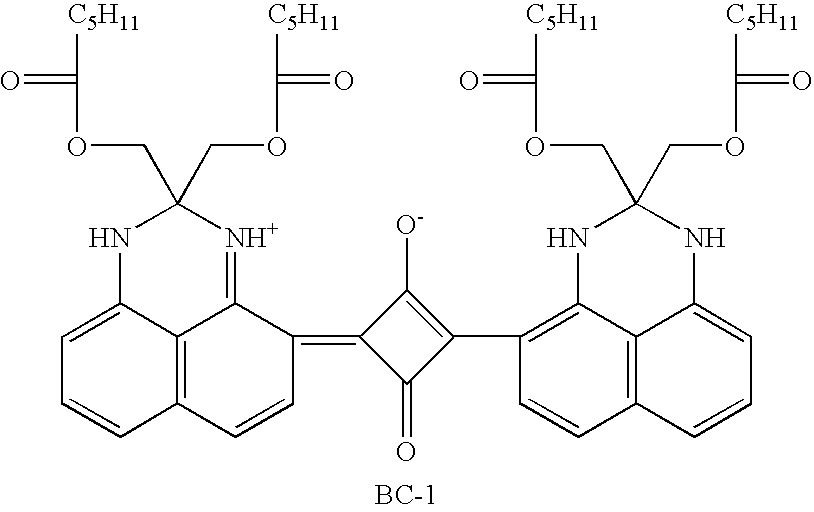Thermally developable materials with backside antistatic layer
- Summary
- Abstract
- Description
- Claims
- Application Information
AI Technical Summary
Benefits of technology
Problems solved by technology
Method used
Image
Examples
##ventive example 1
Inventive Example 1
Use of Quaternary Ammonium Salts in the First Backside Layer
[0297] Buried Backside Non-Conductive Layer Formulation:
[0298] A polymer solution was prepared by dissolving 0.35 parts of VITEL® PE-2700B LMW and 1.39 parts of Eastman CAB 381-20 in 90.34 parts of MEK to form a solution containing 1.89% solids.
[0299] Outermost First Backside Layer Formulation:
[0300] A solution of 39.25 parts of MEK, 39.15 parts of methanol, and 12.17 parts of Eastman CAB 381-20 was prepared.
[0301] A solution of 0.16 parts of Backcoat Dye-1 (BC-1) and 0.38 parts of SYLOID® 74×6000 in 7.37 parts of MEK was prepared. This solution was subjected to high-shear mixing for 15 minutes and added to the polymer solution.
[0302] A dispersion of 0.24 parts Cloisite Na+ in 1.27 parts of MEK was prepared. This dispersion was subjected to high-shear stirring, for 15 minutes and added to the polymer solution.
[0303] 1-Dodecyltrimethylammonium chloride (ARQUAD® R 12-50), 3.88 parts (50% in iso-propa...
##ventive example 2
Inventive Example 2
Evaluation of Additional Quaternary Ammonium Salts
[0311] Additional quaternary ammonium salts were evaluated for their antistatic properties by incorporating them into first layer formulations and coating them directly onto untreated polyethylene terephthalate. In this example, no buried backside layer was used.
[0312] First Backside Layer Formulation:
[0313] A first backside layer formulation was prepared by mixing 23.25 parts of MEK, 69.75 parts of methanol, 7.00 parts of Eastman CAB-381-20, and the amount of quaternary ammonium salt shown below in TABLE III.
[0314] Preparation of Backside Coatings:
[0315] All formulations were coated at a wet thickness of 2.4 mil (61 μm) directly onto a 7 mil (178 μm) unprimed blue-tinted polyethylene support using a laboratory scale automated knife coater equipped with an in-line drier. Samples were dried for 3.5 minutes at 93° C. The dry coating weight of the first backside layer was 2.15 g / m2.
[0316] Evaluation of Samples T...
##ventive example 3
Inventive Example 3
Metal Oxide in Buried Backside Layer and Quaternary Ammonium Salts in First Backside Layer
[0318] Buried Backside Conductive Layer Formulation:
[0319] A backside conductive layer formulation containing zinc antimonate clusters was prepared as described in copending and commonly assigned U.S. Ser. No.10 / 978,205 (filed Oct. 29, 2004 by Ludemann, LaBelle, Koestner, and Chen) and also described below.
[0320] A dispersion was prepared by adding 16.88 parts of MEK to 7.92 parts of CELNAX® CX-Z641M (containing 60% non-acicular zinc antimonate solids in methanol—4.75 parts net). The addition took place over 15 minutes. Strong stirring was maintained for an additional 15 minutes.
[0321] A polymer solution was prepared by dissolving 0.35 parts of VITEL® PE-2700B LMW and 1.40 parts of CAB 381-20 in 41.25 parts of MEK.
[0322] The polymer solution was added to the CELNAX® CX-Z641M dispersion over 15 minutes with strong mixing. An additional 32.21 parts of MEK was then added ov...
PUM
| Property | Measurement | Unit |
|---|---|---|
| Percent by mass | aaaaa | aaaaa |
| Length | aaaaa | aaaaa |
| Mass | aaaaa | aaaaa |
Abstract
Description
Claims
Application Information
 Login to View More
Login to View More - R&D
- Intellectual Property
- Life Sciences
- Materials
- Tech Scout
- Unparalleled Data Quality
- Higher Quality Content
- 60% Fewer Hallucinations
Browse by: Latest US Patents, China's latest patents, Technical Efficacy Thesaurus, Application Domain, Technology Topic, Popular Technical Reports.
© 2025 PatSnap. All rights reserved.Legal|Privacy policy|Modern Slavery Act Transparency Statement|Sitemap|About US| Contact US: help@patsnap.com



